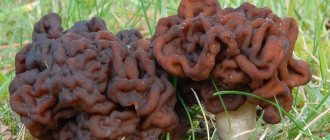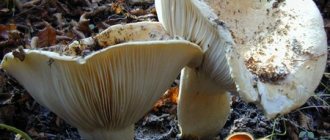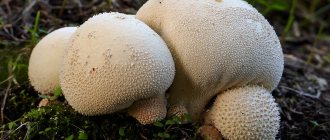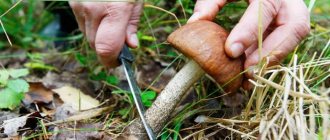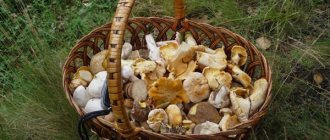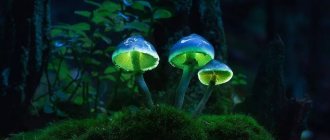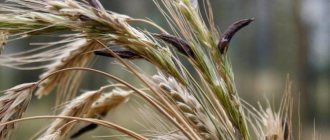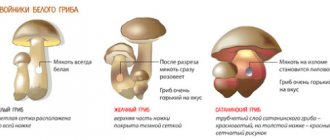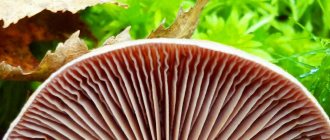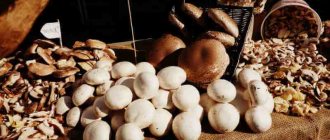Mushrooms
0
1872
Article rating
Kira Stoletova
Mushrooms grow not only in forests, but also in meadows, some of them have adapted to this. Meadow mushrooms, although represented by less species diversity, are also able to satisfy gourmets with their excellent taste.
Description of meadow mushrooms
Under the sun in the wavy grass
Mushrooms have actively populated the entire world around us, and although it is traditionally believed that quiet hunting is a mandatory trip to the forest, in fact, many types of mushrooms prefer not shady forest thickets, but green expanses of fields and meadows, where there is plenty of sun and fresh air, special - field, soil composition, and, if we are talking about pasture meadows - and a lot of nutritious manure, which is very useful for the comfortable habitat of some types of mushrooms.
There are many types of meadow mushrooms, and this article highlights some of them.
Chanterelles
These mushrooms, remarkable for their canary-like appearance, grow quite steadily in the fall and can now bear fruit no less en masse than in the summer. The same can be said about other varieties of chanterelles, of which not all have a yellow-orange color. A separate article is devoted to all of them: “Chanterelles: varieties, places and times of collection,” so I see no point in considering them here, except perhaps for the most famous chanterelle.
Common chanterelle
Photo 30. Chanterelles are typical summer mushrooms; they grow in smaller quantities in the fall, but at times they grow very harmoniously.
It is found everywhere in coniferous and mixed forests, enters into symbiosis with various types of trees, especially with pine , spruce , oak , and beech . The fruiting season is from early June to October , but these mushrooms usually appear most abundantly closer to July and in September.
Meadow Champignon Agaricus Campestris
A mushroom from the Champignon genus, Champignonaceae family, also known as Pecheritsa.
Appearance
- The cap is up to 15 cm in diameter, initially hemispherical, with a rolled edge, later convexly spread out, and may have a fine-scaled structure. The cap is painted white, turning slightly brown over time; the scales in the center may have a brownish tint.
- The hymenophore is lamellar, the plates are thin and frequent, wide and loosely attached, initially white, then turn pink and darken, up to dark brown, with a violet tint. Initially, the plates are covered with a light blanket, which eventually tears, and its remains hang down along the edges of the cap. Spore powder is dark brown in color.
- The leg is up to 10 cm long and up to 2 cm thick, smooth and solid, cylindrical, sometimes slightly narrowed towards the base. The color of the leg is almost the same as that of the leg; at the base it can sometimes be brownish-rusty. The stalk has a wide and thin white filmy ring that often disappears over time. Sometimes it is shifted closer to the middle of the leg.
- The pulp is fleshy and dense, white, turning pink and then turning red when cut, with a pleasant mushroom smell and taste.
Growing conditions
It grows from the end of May to the end of September in open spaces rich in humus soils - meadows, pastures, gardens and parks, even sometimes in cities on fertilized lawns. Fruits in groups every year.
Culinary use
A magnificent and very tasty mushroom, suitable for all types of culinary use. These beautiful porcini mushrooms are well known to all lovers of mushroom cuisine.
Attention!
Meadow Champignon can easily be confused with Pale Toadstool, due to its wide ring and light color, especially young specimens of the mushroom, whose plates have not yet begun to turn pink. You can distinguish them by the presence of an egg - a tuber at the base of the toadstool, but if there is even the slightest doubt that this is a champignon, it is better to leave the mushroom in place - a mistake can cost you your life. Pale Toadstool is rarely found in meadows, but can grow at the edge of the forest, just like Meadow Champignon.
How to distinguish between edible and false
You can use real ones to prepare different dishes - classic ones that are familiar to us, or gourmet delicacies. Poisonous ones are dangerous to health and life. They are quite bitter and look edible. Before harvesting, you should look at the photo and read the detailed description.
Common false species include:
- Wood-loving collibia. Unlike edible honey fungus, it grows under rotten leaves in wooded areas. The leg is small, the cap has a whitish tint. It has a persistent unpleasant odor.
- Talker. This poisonous mushroom comes only in white. It grows in open spaces and has a short stem.
- Winter, summer honey fungus. Outwardly they resemble real ones, but they grow only on tree stumps. They can be edible or fake.
It is worth remembering that even edible mushrooms can become dangerous to humans if they grow next to poisonous ones. You should not collect them if they are close to each other. Before cooking, rinse the product thoroughly with running water. A special solution for washing vegetables is also suitable.
Honey fungus Marasmius Oreades
A mushroom from the genus Negniyuchnik, family Negniychnikov, also known as Meadow or Clove Mushroom.
Appearance
The cap is up to 5-8 cm in diameter, initially conical, then almost prostrate with a blunt tubercle in the center. The oldest specimens can dry out to the point of becoming cup-shaped. The hat is painted in yellowish-brown shades, which become very light when dry, up to off-white.
The hymenophore is lamellar, the plates are sparse and rather wide, initially adherent, then free, painted in whitish-cream shades. White spore powder.
The stem is up to 6 cm high and up to 0.5 cm thick, fibrous and thin, slightly lighter in color than the cap, and becomes very hard with age.
The pulp is thin, pale yellow in color, with a pleasant taste and characteristic odor, similar to the smell of cloves or bitter almonds.
Growing conditions
It grows from June to the end of October in meadows and pastures, in clearings and forest edges, along roadsides. As a rule, it bears fruit in large groups, often forming “witch circles.”
Culinary use
A magnificent and very tasty mushroom, suitable for any type of culinary use.
Attention!
There is a possibility of confusing the Meadow Honey Mushrooms with the poisonous White-faced Talker Clitocybe Dealbata - it also grows in meadows and parks, and often forms “witch circles”. They are really very similar in outline, color, and size. Govorushka can be distinguished by its frequent plates running down the stem, and, of course, by its smell - Govorushka smells dull and inexpressive. In terms of toxicity, this mushroom is inferior to the Pale Toadstool and it is difficult to be fatally poisoned by it, but you can easily get a severe eating disorder.
Where to look
Meadow honey mushrooms love to grow in open areas - clearings, pastures, fields, ravines. The geography of the species is vast - Europe, America, northern Africa. Mushrooms begin to actively appear after rain, when it becomes warm. They form rows, arcs, circles called witch circles (up to 80 cm in diameter). It is best to collect them in late spring or early autumn, if there is steady warmth outside.
Lilac-legged rower Lepista Saeva
A mushroom from the genus Lepista, family Oryadovaceae, also known as Blueleg, Podotavnik and Blue Root.
Appearance
The cap is up to 15 cm in diameter, although specimens up to 25 cm have also been spotted, flat-convex or cushion-shaped, yellowish-violet in color.
The hymenophore is lamellar, the plates are wide, free and frequent, colored in yellowish-cream shades. Spore powder is pale pink.
The leg is up to 10 cm long and up to 3 cm thick, smooth, with a slight thickening at the base, bluish-grayish-violet in color. As it matures, the surface of the stem changes from fibrous and covered with debris to smooth and clean.
The pulp is thick and dense, loosening with age, purple-gray in color, with a pleasant sweetish taste and fruity aroma.
Living conditions
It grows from April to November and can actively bear fruit even at low subzero temperatures. It lives in meadows and pastures, on well-fertilized soils, near old compost heaps, near residential buildings. It can also be found in the forest near deciduous trees.
Culinary use
An excellent edible mushroom suitable for any kind of culinary use.
Umbrella White Macrolepiota Excoriata
A mushroom from the genus Macrolepiot, Champignonaceae family, also known as Umbrella Meadow.
Appearance
The cap is up to 12 cm in diameter, initially elongated - ovoid in shape, then gradually opens up to flat - spread with a large tubercle in the center. The color of the cap is whitish-cream with a brown center, the surface is smooth in the center, covered with thin scales along the periphery. Small flaky fibers are visible along the edges of the cap.
The hymenophore is lamellar, the plates are even and frequent, with small plates and a cartilaginous ring - collarium. The plates are painted in white shades, acquiring brownish-cream shades with age. Spore powder is white.
The leg is up to 12 cm high and up to 1.2 cm thick, hollow and cylindrical, with a slight thickening at the base, sometimes slightly curved. The ring on the stem is white, wide and smooth. Above the ring the leg is white, below it is yellowish-brownish, turning slightly brown when pressed.
The pulp is white, with a pleasant taste and smell, in the stem it is longitudinally fibrous.
Growing conditions
It grows from May to November in meadows and steppe zones, where it reaches its maximum size. Loves well-fertilized humus soils. It can also be found in forests.
Culinary use
A good edible mushroom suitable for various culinary uses.
Attention!
If collected inattentively, the Meadow Umbrella can be confused with the dangerous Lepiota Helveola, which also lives in meadows. The cap of this mushroom is also covered with scales and has a slightly similar coloring. However, Lepiota is much smaller in size - its cap rarely grows more than 6 cm in diameter, and, moreover, it begins to bear fruit only in August, and in Russia it has so far been found only in the Crimea. When cut, the flesh of Lepiota turns pink.
Distribution area: Saratov, Samara, Lipetsk and Lugansk regions
The branch of science about mushrooms that studies their geographic distribution is called mycogeography and makes it possible to determine the places and areas where there are the most forest and meadow mushrooms in the territory of each region.
The distribution area of meadow mushrooms is very extensive and covers almost all soil and climatic zones of our country. The distribution area of fungi has a primary relationship with their food sources and partner plants. The climatic features of the region have a secondary impact on the number and area of distribution of meadow mushrooms.
Both edible and poisonous species grow outside the forest. When collecting meadow mushrooms, you should definitely learn to distinguish edible and conditionally edible species from inedible and deadly poisonous ones.
Of course, the most valuable from the point of view of nutritional value and taste are the porcini mushrooms themselves, which are often called meadow mushrooms, and boletus mushrooms. However, according to the observations of experienced mushroom pickers, forest mushrooms are of higher quality than those growing in the meadow, since they are less likely to be wormy.
Yellow-skinned champignon Agaricus Xanthodermus
A mushroom from the genus Champignon, Champignonaceae family, also known as Yellow-skinned Cave.
Appearance
The cap is up to 15 cm in diameter, initially round and then bell-shaped, painted in yellowish tones, with a brown center.
If you press on the cap with your finger, this place will turn sharply yellow.
The hymenophore is lamellar, the plates are thin, initially pinkish in color, then become grayish-brown. Spore powder is dark brown.
The leg is white, up to 15 cm long, up to 2 cm in diameter, hollow, with a tuberous thickening at the base. There is a light ring on the stem.
The pulp is brownish in color, the lower part of the stem is yellowish, and inside the tuberous swelling is yellowish-orange. The pulp has a pronounced unpleasant phenolic odor, which is especially intensified by heat treatment. When cooked, the flesh also turns yellower.
Living conditions
Yellow-skinned Champignons grow from July to October, both in mixed forests and in meadows, parks and gardens.
Danger level
The chemical properties of this species have not yet been identified, and some people eat this mushroom, however, the statistics of poisoning by the Yellow-skinned Champignon strongly indicate the fallacy of this strategy. The fungus is not fatal, but with a very high probability it can cause serious food poisoning in humans.
Application
In the food industry
Due to their taste and the content of a significant amount of useful substances, the use of meadow mushrooms in the food industry is widespread.
They are used in both first and second courses, boiled, salted, pickled, stewed, frozen, and dried. The exception is raincoats, which are only suitable for frying without pre-cooking. For meadow mushrooms, as a rule, only the caps are used, since their legs are very hard.
In pharmaceuticals
- Meadow champignon . Oil extracts are used to treat skin diseases. In folk medicine, it is recommended for consumption in cases of diabetes, excess weight, bronchitis, asthma, tuberculosis, typhus, hepatitis, mumps, to improve brain activity, and strengthen memory.
- Honey fungus . Used in weight loss diets due to their low calorie content. It has antifungal, antiviral functions, has a positive effect on the functioning of the thyroid gland, dilates blood vessels, and actively fights cancer cells, tuberculosis, pneumonia, bronchitis, radiculitis, and arthritis. The marasmic acid contained in it is destructive to staphylococcus and a number of other bacteria.
- Meadow raincoat . It has hemostatic and wound healing properties. The decoction is used to treat bronchitis, tuberculosis, and laryngitis. Used for burns, acne, urticaria. The calvacic acid contained in the composition is the basis of the anti-cancer drug calvacin.
- Meadow umbrella . Recommended for weight loss and diabetes.
- Lilac-legged rower . Ointments for skin diseases are made from the bluelegs infusion, an anti-cancer extract is made from the mycelium, and a facial lotion for problematic and excessively oily skin is made from the dried product. Useful for diseases of the heart, liver, gastrointestinal tract, genitourinary system, diabetes, weakened immunity, headaches, chronic fatigue, and nervous disorders.
- Yellow-skinned champignon . From the fruiting body of the poisonous mushroom, psalliotin and agaricin are isolated - antibiotics that destroy salmonella, staphylococcus, streptococcus, suppressing the activity of cancer cells.
Important! You should not self-medicate with mushrooms. Before using them, it is still worth seeking advice from specialists.
Despite the fact that meadow mushrooms are less diverse than their forest counterparts, they have excellent taste and contain many nutrients and beneficial substances.
Pheolepiot Golden Phaeolepiota Aurea
A mushroom from the genus Theolepiot, Champignonaceae family, also known as Mustard and Golden Umbrella.
Appearance
The cap is up to 25 cm in diameter, at first hemispherical, then convex - spread out, with a small tubercle in the middle. The hat is painted in ocher-yellow shades, sometimes with an admixture of orange. There is a pronounced granularity on the cap, especially noticeable in young mushrooms.
The hymenophore is lamellar, the plates are thin and frequent, adherent, initially colored in pale yellowish-ocher shades, and with age they become rusty-brown. Spore powder is rusty brown.
In young specimens, the plates are covered with a membranous blanket, which tears over time, often leaving tatters on the edges of the cap.
The leg is up to 20 cm high and up to 5 cm wide, straight, may have a thickening in the middle and a thickening at the base. The stem of young mushrooms is colored approximately the same as the cap, and also has a pronounced graininess, then darkens to a rusty-brown hue. After the covers fall off the plates, a film ring remains on the stem, the same color as the stem.
The pulp is fleshy and thick, without a pronounced taste or smell, whitish, yellowish or reddish.
Living conditions
It grows from July to the end of October in fields, meadows and pastures, along roads or in forest clearings in deciduous forests, on richly fertilized soils.
The mushroom is listed in the Red Books of some Russian regions.
Danger level
Previously, this species was classified as conditionally edible, which can be eaten after preliminary boiling for half an hour, but now it is considered inedible due to suspicion of an increased ability to accumulate substances harmful to humans.
How to freeze autumn mushrooms in 2022?
Not every housewife knows that you can freeze not only fresh mushrooms, but also boiled and fried ones. But only young, strong fruiting bodies are suitable for this, preferably whole. Boletus and boletus are processed and frozen immediately after collection. Boletus mushrooms, russula, boletus, champignons, honey mushrooms, sweet mushrooms, and saffron milk caps are cleaned (do not wash!) within 24 hours. Spread in a thin layer on trays and freeze at the lowest temperature. After 10-12 hours, put into bags, tie, and place in the freezer at normal storage temperature.
It is better to cut lamellar or non-marketable mushrooms and boil them for 5 minutes. You can fry them in vegetable oil or in the oven in their own juice for about 20 minutes. After cooling, distribute them into bags and put them in the freezer. This is an ideal filling for pies and stuffing. The main thing is to defrost it correctly afterwards! Transfer the product into a container and place it on the bottom shelf of the refrigerator.
Hygrocybe Yellow – Green Hygrocybe Chlorophana
A mushroom from the genus Hygrocybe, family Hygrophoraceae, also known as Hygrocybe Dark Chlorine.
Appearance
The cap is up to 7 cm in diameter, first hemispherical, then convex, and finally almost flat in shape, sometimes with a small depression or tubercle in the center. The hat is painted in lemon-yellow tones, is slightly sticky and has a ribbed edge.
The hymenophore is lamellar, the plates adhere to the stalk, initially light, then turn yellow, up to a yellow-orange hue. Spore powder is white.
The stem is up to 8 cm long and up to 1.2 cm thick, slightly lighter in color than the cap, fragile, and becomes hollow with age.
The pulp is brittle and yellowish, without a pronounced taste or smell.
Growing conditions
Grows from May to October in meadows and mixed forests, singly or in small groups.
Danger level
The mushroom is often classified as inedible, but not because of its potential danger, but because of the absence of any of its taste or culinary qualities known to most collectors. However, purely technically, you can eat it.
Which tube mushrooms are poisonous?
They are not fatally poisonous, but cause gastrointestinal disorders and various poisonings. The list of poisonous tubular mushrooms includes the following representatives: wolf's boletus, pepper and gall mushrooms, and satanic bolete. The only deadly poisonous tubular representative is the satanic mushroom. It is similar to boletus.
Interesting materials:
Which professional dye is best for gray hair? What bird brushes a hippopotamus' teeth? Which bird copies sounds? What bird sings late at night? What is the installment plan for Halva in the 21st century? Which plain is the largest? Which plain is located in eastern China? What is the difference between soda ash and baking soda? What is the difference between markers and felt-tip pens? What is the difference between MRS MS?
Psilocybe Semilanceata
A mushroom from the genus Psilocybe, family Hymenogasteraceae, also known as the Liberty Cap and Veselushka.
Appearance
The cap is up to 25 mm in size, conical or semicircular in shape, with a small tubercle at the end and mucous skin. The color of the cap varies from beige to olive brown, depending on the degree of humidity.
The hymenophore is lamellar, the plates are sparse, initially ocher, and then grayish-black, with a white edge. Spore powder is dark brown.
The leg is up to 10 cm high and up to 3 mm in diameter, very thin and tall, strong, elastic and hollow, often slightly curved. The leg is painted in whitish-yellowish shades, often with a bluish base. Sometimes scales are visible on it.
The pulp is thin, yellow-cream in color, with a weak taste and a slight smell of mold. When broken and dried, the flesh turns blue.
Growing conditions
It grows from late August to November, in meadows, fields and pastures, loves high humidity and not very high temperatures.
Mode of application
Connoisseurs collect Semi-lanceolate and other similar types of psilocybin mushrooms, the names of which are listed in detail in the Russian criminal code, dry them using a special technology, and then chew the dried mushrooms to get a psychedelic trip. This activity is exciting, but very unsafe. Firstly, according to Russian laws, for the purposeful collection, cultivation or sale of psilocybin mushrooms you can easily and for a long time go to prison. Secondly, experiments with your own consciousness are a very unpredictable thing, so we advise you to think carefully before becoming more familiar with the properties of these peculiar meadow inhabitants.
Growing under the friendly sun, meadow mushrooms, no less than forest mushrooms, are able to delight us with the variety of their shapes, colors, properties and tastes. And the difference between meadow silent hunting and forest hunting will always add new interesting experience and knowledge to you.
Edibility, beneficial properties and restrictions on consumption
Pecheriki are not only edible and completely usable, but also very beneficial for health. They also rank first among all mushrooms allowed for consumption during pregnancy.
Champignons are enriched with folic acid (vitamin B9), under the influence of which the following occurs:
- normalization of the cardiovascular system;
- increased production and renewal of red blood cells;
- improving metabolism;
- stabilization of the functioning of the nervous and digestive systems.
Despite its satiety, pecheritsa is a low-calorie mushroom. For this reason, nutritionists allow its use in case of excess body weight. In addition, the fruit contains many proteins and antioxidants that stimulate metabolic processes. Properly prepared pecheritsa will be very beneficial for people suffering from diabetes.
A strict contraindication to the use of the product is individual intolerance to the human body. Also, since mushrooms are difficult to digest, it is not recommended for people suffering from gastrointestinal diseases.
